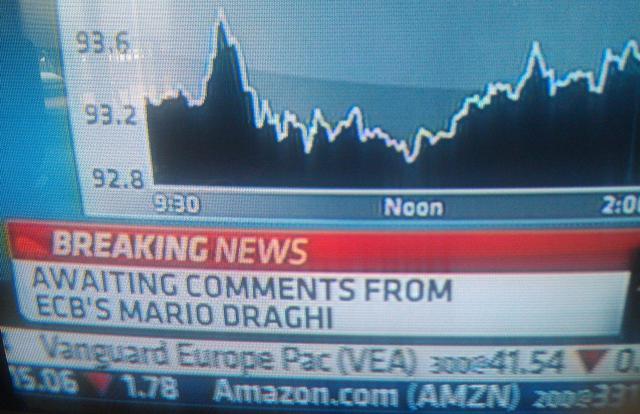 While mankind has tried and will probably never give up on such attempts, there is a reason many are assigned to the fact that you just can’t fight nature.
While mankind has tried and will probably never give up on such attempts, there is a reason many are assigned to the fact that you just can’t fight nature.
In the case of natural disasters, those forces are so powerful and so relentless the best you can hope for is that they will run their course before nature finds its way to you.
Fleeing is probably a better strategy than fighting when faced with the release of unfathomable stores of energy in an effort to buy time until the inevitable reversal of course occurs.
Sure, you can build shelters, fortify dams or enact more stringent building codes in efforts to mollify the impacts of nature, but eventually, we all know who’s in charge.
Economic cycles, stock market cycles, currency cycles and interest rate cycles aren’t very different. They represent incredibly powerful forces that governments attempt to manipulate, but it is really only time that can tame the unwieldy power of an event, regardless of government intervention.
It’s those natural cycles, sometimes a cascade of events coming to a crescendo that are like the worst that Mother Nature has to offer.
Most of us know that trying to best nature is a fairly futile way to expend our own energy, just as is trying to manipulate or change the direction of capital markets. Over the past 50 years there is plenty of evidence to show that heavy handed government attempts to manipulate markets, such as currencies, have exceedingly short impacts.
You can’t really blame the Chinese government for trying to control their stock markets, though, especially in a time of crisis.
They’re pretty new at this capitalism game and it’s only through surviving one of the varied crises that descend upon the cogs of capitalism on occasion that you can continue to reap its many benefits.
Undoubtedly someone in a high position of authority must have seen footage from a 70 year old cartoon and had it mistaken for real news footage of someone successfully battling with a force of nature and then drew the obvious conclusion that the same would be possible as their market was threatening a meltdown.
In a system where it controls everything and has a bully pulpit in more than just figurative terms, it’s only natural to think that it could just as easily exert its will on its stock market and change its behavior.
But what we know is that the forces seen in capital markets is no different from those seen in nature, at least in terms of how unlikely it is that human efforts can suddenly change the course.
Of course, in a nation that executes many for white collar crimes, official condemnation of “malicious short sellers” who being blamed for the bursting bubble and threatened with investigation and arrest can certainly lead to behavioral changes, but not the kind that can stem the inevitable path as gravity takes control of sky high stock prices.
Learning that market forces aren’t as easily controlled as 1.4 billion people isn’t very easy when you actually do have the power to control those 1.4 billion people. That itself is so improbable that everything else must seem like a cakewalk.
When you have the power to tell people that they can only have one child, and they obey the edict, you’ve shown that you’re pretty good at battling nature and what comes naturally. So it’s only natural that when faced with a brewing crisis in their stock markets, the Chinese government would elect to try and alter its natural course.
Good luck with that.
The combination of events in China, the ongoing battle among Greece, the EU, ECB and IMF and the trading halt on the NYSE resulted in a week that saw large moves in both directions, intra-day reversals in both directions and ultimately ended the week unchanged.
There wasn’t too much doubt that events in China determined our own fortunes this past week as the net result of the interventions was to see their markets recover and spill over onto our shores. While I saw reason to establish some new positions last week as the market opened the week on a sharp decline, and was fortunate to have benefited from market strength to close the week, I’m circumspect about the ability of the Chinese government intervention to have anything more than a temporary halting impact. Being mindful of so many past attempts by governments to halt slides in their currency by massive entry into currency markets, makes me want to hold on tightly to any cash that I have as this week is about to begin.
Perhaps some good economic news will be forthcoming this week as earnings season really gets underway in earnest. Maybe some good news can move our attention away from world events, but ignoring those powerful overseas forces would be a mistake, particularly as the Chinese government’s actions may be unpredictable if their initial attempts at controlling their stock markets don’t succeed.
This coming week may offer a wild ride in both stocks and bonds and if so, we’d be very fortunate if the net result was the same as this past week, but you can be lucky only so often in the face of unleashed natural forces.
As usual, the week’s potential stock selections are classified as being in the Traditional, Double-Dip Dividend, Momentum or “PEE” categories.
With fewer compelling reasons to spend money this week there aren’t too many stocks that have much in the way of appeal to me at the moment and my selections for this week continue to be limited.
As long as China is front and center, there may be some reason to think about YUM Brands (NYSE:YUM) as it both reports earnings this week and goes ex-dividend.
Over the past few years it seems that there have been an infinite number of disasters that have come YUM’s way, as so much of its fortunes rely on its businesses in China which can so easily fall prey to the weakest links in the chain, as well as to the macro-economic picture.
Following a large move higher on Friday, I wouldn’t rush into any kind of position unless there was some pullback. However, in the event that some of that gain is returned prior to earnings on Tuesday, I would consider a covered call trade, rather than the sale of puts, in order to also be able to capture the dividend the following day.
The option market is implying a 6.4% move next week. At Friday’s closing price of $90.87, the implied lower boundary is about $85. The option premium being offered for the weekly $85 strike would offer a 0.75% ROI if assigned early and a 1.2% ROI if the dividend is captured.
Since earnings are reported on Tuesday after the market’s close and the ex-dividend date is the following day, there is a very short window of opportunity for an option holder to exercise following earnings. The owner of shares would have approximately $6 of downside protection, although YUM shares can certainly be very volatile when earnings or any adverse news is reported.
I have some mixed feelings about considering Caterpillar (NYSE:CAT) this week, as so much focus is placed on its dependence on Chinese economic activity. Overall revenues from the Asia-Pacific region account for about 20% of total revenue and has already been hard hit as it share price is down nearly 25% since November 2014 and 7% in the past 2 weeks. While its CEO tried putting a positive spin on the Chinese economic slowdown a few months ago, he may have to spin extra hard now.
Caterpillar shares go ex-dividend this week and that is certainly a selling point, as its shares are approaching their 52 week low and I have been wanting to add shares for quite a while.
I would be willing to take the risk of their China exposure in the event of any additional price weakness as the week begins in the belief that any disappointing earnings or guidance the following week may have already been discounted.
I have less mixed feelings about Lowes (NYSE:LOW) which goes ex-dividend the following Monday. Lowes shares are down about 10% in the past 3 months and 4% in the past 2 weeks.
What I don’t have mixed feelings about is the quality of the shopping experience at Lowes. I’ve spent lots of time there lately, having become a convert from Home Depot (NYSE:HD) on the advice of a friend who suggested that I try them for a large DIY project I was ready to undertake.
In the past 2 months I have probably made about 20 trips, bypassing that Home Depot store and have noticed that the store always seemed busy and I tended to make more purchases as their sales associates were proactive and helpful.
While I generally like to consider Monday ex-dividend positions, that’s more true when weekly options are available, in an attempt to get 2 weeks of premium instead of the dividend, in the hopes of an early assignment. However, Lowes no longer has weekly options available and while this is the final week of the July 2015 cycle, the ex-dividend date is part of the August 2015 cycle.
With that potential purchase comes the potential liability associated with earnings, which are scheduled to be reported 2 days before the end of the monthly cycle. For that reason I might consider a purchase coupled with the sale of a September or later option, in order to capture the dividend and provide some cushion in the event of a downward price move.
I haven’t owned Baxter International (NYSE:BAX) in almost 2 years and have a very difficult time understanding why that has been the case, as it traded in a very narrow band that entire time while offering a reasonable option premium and attractive dividend.
Having now completed its spin off of Baxalta (NYSE:BXLT), it may join other companies that fell out of favor as they were perceived as less desirable after spinning off their faster growing assets. Whether that’s actually supported by reality may be questionable, but there’s no question that spin-offs, such as Baxalta and the upcoming PayPal (PYPLV) have gotten attention.
For its part, what remains of Baxter is a company that offers an excellent dividend and attractive option premiums in an industry sector that shows little sign of slowing down.
Finally, I purchased shares of Abercrombie and Fitch (NYSE:ANF) last week and happily saw them assigned. I still hold a much more expensive lot of shares and every little bit of premium derived from additional short term lot holdings helps to ease the pain of that non-performing lot.
Last week’s purchase was the third such in the past 10 weeks as Abercrombie and Fitch’s shares have been trading in a very narrow range, but its option premiums still reflect its historical ability to make large moves. Lately, those large moves have been predominantly lower and certainly any time new shares are added the risk remains of continued erosion of value.
While teen retailers haven’t been terribly good stores of stock value of late, and while there’s certainly nothing positive that can be said of Abercrombie and Fitch, it won’t report earnings again until the end of August and continues to present a short term opportunity.
However, following a price reversal during Friday’s session, that saw it’s shares close higher for the day, I would consider an entry this coming week only on weakness, if considering a covered call position. Alternatively, the sale of puts may have some more appeal, especially if there’s price weakness as the week begins and moves the share price closer to $21.
Traditional Stocks: Baxter International
Momentum Stocks: Abercrombie and Fitch
Double-Dip Dividend: Caterpillar (7/16), Lowes (7/20)
Premiums Enhanced by Earnings: YUM Brands (7/14 PM)
Remember, these are just guidelines for the coming week. The above selections may become actionable, most often coupling a share purchase with call option sales or the sale of covered put contracts, in adjustment to and consideration of market movements. The overriding objective is to create a healthy income stream for the week with reduction of trading risk.

 I used to work with someone who used the expression “It’s as clear as mud,” for just about every occasion, even the ones that had obvious causes, answers or paths forward.
I used to work with someone who used the expression “It’s as clear as mud,” for just about every occasion, even the ones that had obvious causes, answers or paths forward. For all the talk about how April was one of the best months of the year, that ship sailed on April 30th when the DJIA lost 192 points, to finish the month just 0.2% higher.
For all the talk about how April was one of the best months of the year, that ship sailed on April 30th when the DJIA lost 192 points, to finish the month just 0.2% higher. This was one of those rare weeks where there wasn’t really any kind of theme to guide or move markets.
This was one of those rare weeks where there wasn’t really any kind of theme to guide or move markets. It was interesting listening to the questioning of FOMC Chairman Janet Yellen this week during her mandated two day congressional appearance.
It was interesting listening to the questioning of FOMC Chairman Janet Yellen this week during her mandated two day congressional appearance. An incredibly quiet and uneventful week, cut short by the Thanksgiving Day holiday, saw the calm interrupted as a group of oil ministers from around the world came to an agreement.
An incredibly quiet and uneventful week, cut short by the Thanksgiving Day holiday, saw the calm interrupted as a group of oil ministers from around the world came to an agreement. Pity the poor hedge fund manager.
Pity the poor hedge fund manager. It’s too bad that life doesn’t come with highly specific indicators that give us direction or at least warn us when our path isn’t the best available.
It’s too bad that life doesn’t come with highly specific indicators that give us direction or at least warn us when our path isn’t the best available.
 This past week was one when neither decisions nor inputs were really required from investors as the market had its best week in about four months. With the exception of a totally inconsequential FOMC statement release, there was absolutely no economic news, or really no news of any kind at all. In fact, awaiting the scheduled remarks from Mario Draghi was elevated to the status of “breaking news” as most people were tiring of seeing celebrities getting doused with a bucket of ice, under the guise of being news.
This past week was one when neither decisions nor inputs were really required from investors as the market had its best week in about four months. With the exception of a totally inconsequential FOMC statement release, there was absolutely no economic news, or really no news of any kind at all. In fact, awaiting the scheduled remarks from Mario Draghi was elevated to the status of “breaking news” as most people were tiring of seeing celebrities getting doused with a bucket of ice, under the guise of being news.
